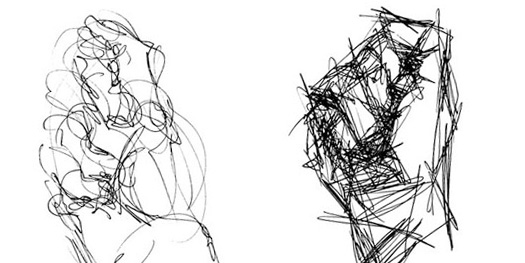
Wire Drawing Exercise
Example from save-janos.net – this example has been placed on a painted acrylic background
With this exercise you are not going to be drawing at all. All you need is some wire and a pair of pliers with cutters. My favorite wire for this exercise is tie wire and you can get it almost any hardware store. The idea is to explore shapes and lines that you create by bending the wire. This exercise will force you to focus more on the line and less on the “drawing.” The nature of the wire also makes it more difficult to create tight corners. Don’t fight this and allow the properties of the wire to influence your piece.
Non-dominant Hand
Give your non-dominant hand a chance to shine. Control is not always a good thing and, unless you are ambidextrous, this exercise will require you to give up much of your learned control. By drawing with your non-dominant hand you are giving yourself the opportunity to be more free with your line. During this exercise you should notice your line becoming more loose and fluid.
Draw Vertically
you should be doing most of these drawing exercises vertically if you have an easel or drawing horse. Drawing vertically is a great way to loosen up your line. Focus on drawing with your entire arm and not just your hand. Drawing this way will also allow you to get your line recorded faster. Remember, focus on looking at what you are drawing as much as the drawing itself and do not stop moving your hand when you look up.
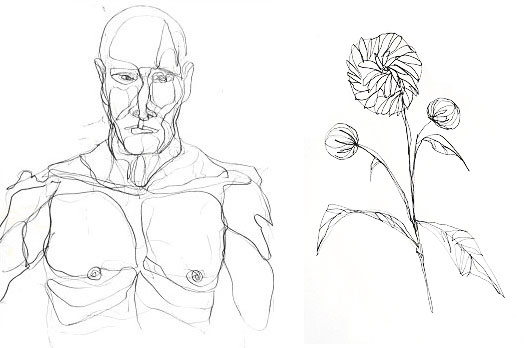
Continuous Contour Line Drawing
Examples from Draw and Paint Online
A Continuous Contour Line Drawing is an exercise to help us focus on the line. The idea here is to create a drawing where you never lift your drawing utensil from the paper. I like to use a pen on this one to help me resist the urge of erasing mistakes. If you have never done this exercise you may find your drawings odd and “imperfect” but that is what makes them beautiful. Also focus on looking at what you are drawing as much as the drawing itself and do not stop moving your hand when you look up.
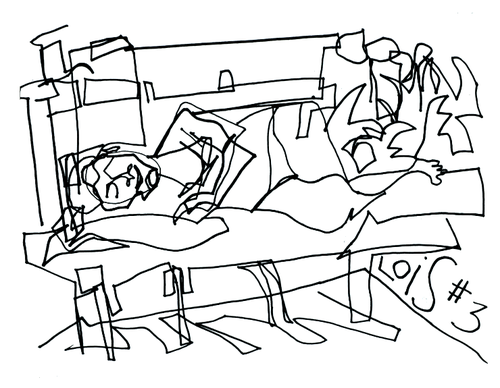
Continuous Blind Contour Line Drawing
Example from Anne Leuck Feldhaus
If you enjoy the contour line exercise, then you should certainly try this one. In this exercise, look only at the subject that you are drawing and not at the paper. Yes, you read that correctly. Again, I use a pen in this exercise and try to coordinate your hand and eyes to work together, recording the lines as your eyes follow them. The idea here is to train your hand and eyes to work in unison. As you do more blind contour line drawings you will get better and begin seeing some wonderful, fluid lines.
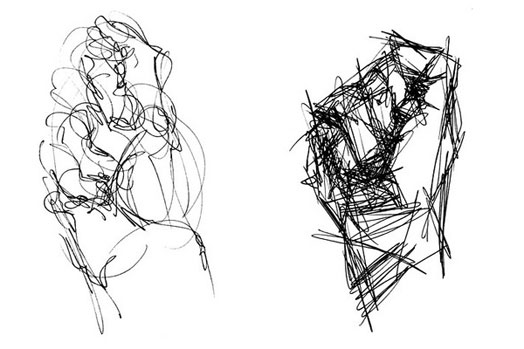
Gesture Drawing
Example from about.com – the one on the right is an example of tighter more expressive execution
In this exercise you want to get as much information down on the paper in short amount of time. You will be doing a series of drawings here, so make sure you have plenty of paper and a timer on hand. The first drawings you only have 20 seconds to complete. Yes 20 seconds! Repeat the 20 second drawings about 10 times and increase the timer to 40 seconds. You want to be bold with these drawings and forget about the “mistakes” that you are making. Make sure you keep drawing like you were when you only had 20 seconds. Increase the time again to 2 minutes after you have completed about 10 drawings at 40 seconds. You should begin to notice improvement in your line quality as become more confident with your drawing. Also focus on looking at what you are drawing as much as the drawing itself and do not stop moving your hand when you look up.
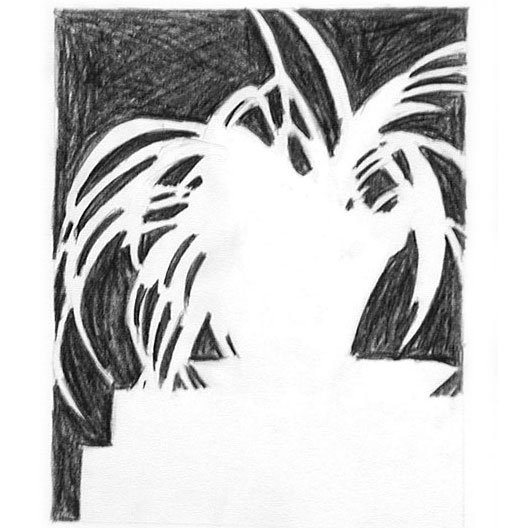
Draw the Negative Space
Example from NBCC.ca
In this exercise you will be drawing the space around the object, negative space, rather than the object itself. First try using a solid marking as shown above to create a very flat looking finished product. I would also suggest doing some where you draw the negative space more realistically. And, don’t forget to focus on looking at what you are drawing as much as the drawing itself .
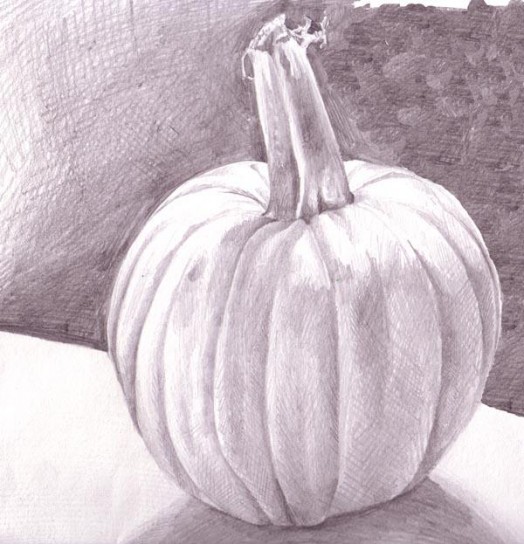
Value Drawing Exercise
Example from Julie’s Journal
Usually when drawing we begin sketching the outline of the object we are drawing. In this exercise, do not drawing a single line. Instead, simply shade using your favorite drawing utensil and build the drawing up this way. I suggest using charcoal or something large that will allow you to put your shading down quickly. You can always erase or add white Conte if your shading gets too dark. You should still be looking at what you are drawing as much as the drawing itself and do not stop moving your hand when you look up.
I know that many of you know all of these as they are very common exercises. If they are new to you, hopefully these help and good luck to you with your drawings! If you have a favorite that I didn’t include, please add it in the comments.
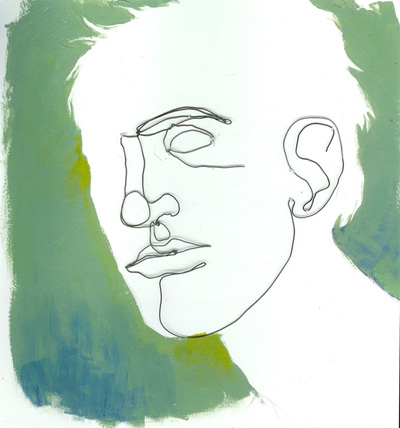


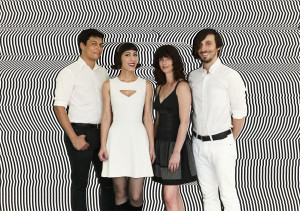
Thanks, good to be reminded of these sometimes. The craziest one that I ever heard of is stand on your head and draw with your non-dominent hand. I have not tried this though, not sure I am that coordinated.
I recommend reading Kaupelis’ “Experimental Drawing” for a ton of other fun and enriching exercises.
Some very important ones i’d had to the list:
– Smudge drawing (avoiding the use of lines, using charcoal and other blunt instruments, helps develop a sense of high contrast, but the approach may be more stylish than realist)
– Positive drawing (the same technique for negative drawing, but with an enphasis on avoiding sillouette contours. try to draw only the inside of a model – very hard to master!)
– Fast drawing (probably the best exercise and the hardest. time your drawings. 7sec ones are my favourites. You should get someone to model for you and change pose by the clock)
that’s about all i can remember right now. I’m sure there’s more of course.
Good work on this list. Nice to stumble upon it.
Thanks for the info! I will certainly check that out.
This is a wonderful opinion. The things mentioned are unanimous and needs to be appreciated by everyone.
exercises
drawing white objects on white backgrounds is a great way to learn to see value … an egg on white paper for example…
Negative space drawings are really cool imho. A great start if you are sued to still life drawing, but want to branch out a bit.
I feel you really should be aware that the comment prior to me may be unsolicited mail.
@kup dom – thanks, I am getting a lot of that these days. My spam tools are only so good I guess. Thanks for the heads up!
The example for the value exercise is a real bad one, the pumpkin doesn’t appear to be in the third dimension. Why on earth would you practice with your weaker hand, when you already have a dominant. The continous blind contour Drawing is a joke, that doesn’t teack drawing, it teaches copying. Drawing is designing with a pencil, not drawing what one sees. Looking at great artists of the past (Raphael, Michaelangelo, Leonardo) noone ever drew what they saw. Copying what you see isn’t drawing, much less scribbling on paper without seeing what mess you’re causing
Re Alex Vablahblahblah (omit “Alex Verble-Diarrhea”)
“A man with little learning is like the frog who thinks its puddle a great sea” —Burmese proverb
@Alex Vablahblahblah: I can understand where you are coming from and shared many of the same thoughts that you expressed before actually trying these exercises. Drawing came very natural to me at a young age and I felt confident in my skill, cringing when others would try to teach me anything.
When I was in college level drawing classes, my instructor forced me to do some of these exercises. I found that these exercises helped me loosen up and draw with my whole arm rather than just my hand. Also, my drawing scale grew in size and I could crank out dozens of drafts before settling on the composition, angle, etc. that I wanted to explore.
So, I would encourage you to try doing these. You will likely hate it at first so give it a few months. Buy large, cheap newsprint and go nuts.
I’m always up for experimentation. A wise man believes firmly in the benefits of getting outside your comfort zone. You can’t let your work/style stagnate.
A very useful summary. Thank you. Now for a try…
Some great stuff here. Another exercise I find really helpful is to deconstruct and simplify structures. Essentially you take a complex image or object and break it down into its simple shapes and geometry. Most things can be broken down into cubes, spheres and cylinders. This will help artist gain a great understanding of the object, and makes it easier to draw something in the future 🙂